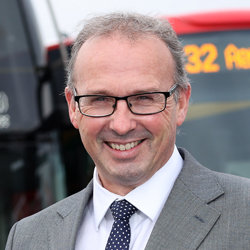
Stephen Kent
Chief Executive Officer, Bus Éireann
Balancing the need to serve a growing population while cutting public transport emissions is a challenge that must be met.
Transport has been the fastest growing source of greenhouse gas emissions in Ireland. They have doubled in 30 years and make up almost one fifth of total emissions. Cutting this by half to meet the Climate Action Plan targets while serving a growing population and facilitating economic growth requires a profound transformation in our transport system.
Range of technological solutions
Strategies that have worked in other countries may not do so here. Ireland’s population structure is different; our cities and towns are not alike and our geography is highly varied for such a small country. As the national bus company, our services reflect that. Funded by the National Transport Authority, we are testing a range of solutions, knowing that no new diesel bus will ever again be added to our urban fleet.
This year, Galway became the first city here to be served by an all-hybrid fleet. This is delivering almost a 30% reduction in emissions. Next year, Athlone will be our first all-electric town.
Hydrogen powered
For longer, cross-country routes, hydrogen fuel cell electric vehicles may be the answer. We have three double-deckers in operation – the only hydrogen-fuelled vehicles in use in Ireland. They refuel within 10 minutes, about the same time as it takes to fill a tank on a diesel bus. They have a range of up to 400 kilometres. Their only emission is water. Investment in hydrogen production and, crucially, fuelling infrastructure could render this a transformative technology.
Congestion challenge
Electric vehicles mean cleaner air in towns and cities and a quieter, smoother journey for passengers, helping to encourage people out of cars and on to public transport.
But the greatest impediment to getting people out of their cars is other people’s cars. Congestion challenges service reliability and is projected to cost €2 billion a year in Dublin alone by 2033. In Cork, part of the city that should take three minutes to travel often takes half an hour. There are only 30 kilometres of bus lanes outside of the greater Dublin area.
The NTA’s roll out of BusConnects to all cities will allow us to offer certainty of journey time, creating the opportunity for an unprecedented shift in how we travel. Investment in making services more frequent sees passenger numbers grow by at least 25% in 12 months.
None of this is simple. It is critically important and urgent. But the solutions are here and with cooperation and coordination, bus transport will deliver.


